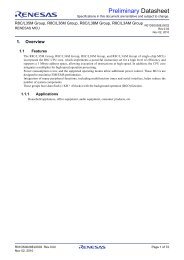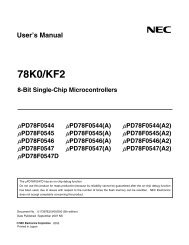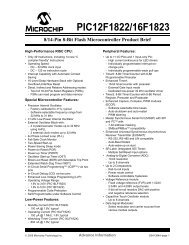xmega a3u - Elfa
xmega a3u - Elfa
xmega a3u - Elfa
You also want an ePaper? Increase the reach of your titles
YUMPU automatically turns print PDFs into web optimized ePapers that Google loves.
XMEGA A3U<br />
The arithmetic logic unit (ALU) supports arithmetic and logic operations between registers or<br />
between a constant and a register. Single-register operations can also be executed in the ALU.<br />
After an arithmetic operation, the status register is updated to reflect information about the result<br />
of the operation.<br />
The ALU is directly connected to the fast-access register file. The 32 x 8-bit general purpose<br />
working registers all have single clock cycle access time allowing single-cycle arithmetic logic<br />
unit (ALU) operation between registers or between a register and an immediate. Six of the 32<br />
registers can be used as three 16-bit address pointers for program and data space addressing,<br />
enabling efficient address calculations.<br />
The memory spaces are linear. The data memory space and the program memory space are<br />
two different memory spaces.<br />
The data memory space is divided into I/O registers, SRAM, and external RAM. In addition, the<br />
EEPROM can be memory mapped in the data memory.<br />
All I/O status and control registers reside in the lowest 4KB addresses of the data memory. This<br />
is referred to as the I/O memory space. The lowest 64 addresses can be accessed directly, or as<br />
the data space locations from 0x00 to 0x3F. The rest is the extended I/O memory space, ranging<br />
from 0x0040 to 0x0FFF. I/O registers here must be accessed as data space locations using load<br />
(LD/LDS/LDD) and store (ST/STS/STD) instructions.<br />
The SRAM holds data. Code execution from SRAM is not supported. It can easily be accessed<br />
through the five different addressing modes supported in the AVR architecture. The first SRAM<br />
address is 0x2000.<br />
Data addresses 0x1000 to 0x1FFF are reserved for memory mapping of EEPROM.<br />
The program memory is divided in two sections, the application program section and the boot<br />
program section. Both sections have dedicated lock bits for write and read/write protection. The<br />
SPM instruction that is used for self-programming of the application flash memory must reside in<br />
the boot program section. The application section contains an application table section with separate<br />
lock bits for write and read/write protection. The application table section can be used for<br />
safe storing of nonvolatile data in the program memory.<br />
6.4 ALU - Arithmetic Logic Unit<br />
The arithmetic logic unit (ALU) supports arithmetic and logic operations between registers or<br />
between a constant and a register. Single-register operations can also be executed. The ALU<br />
operates in direct connection with all 32 general purpose registers. In a single clock cycle, arithmetic<br />
operations between general purpose registers or between a register and an immediate are<br />
executed and the result is stored in the register file. After an arithmetic or logic operation, the<br />
status register is updated to reflect information about the result of the operation.<br />
ALU operations are divided into three main categories – arithmetic, logical, and bit functions.<br />
Both 8- and 16-bit arithmetic is supported, and the instruction set allows for efficient implementation<br />
of 32-bit aritmetic. The hardware multiplier supports signed and unsigned multiplication and<br />
fractional format.<br />
8386B–AVR–12/11<br />
8

















